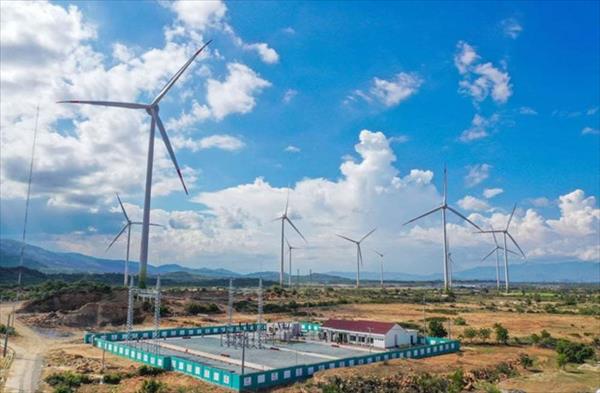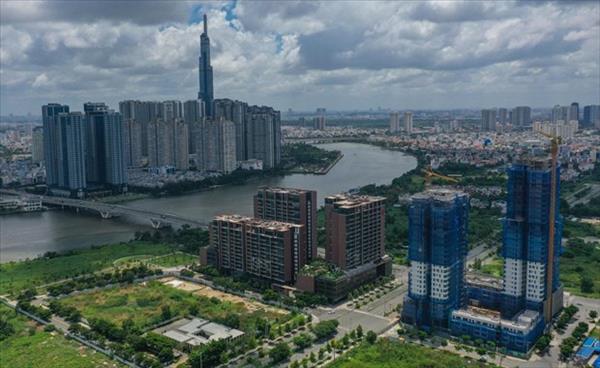Hanoi, May 3 (VNA) – Experts have proposed the construction of five to seven dams along the Hong (Red) River to raise the water level, thus serving agricultural production and water transport without affecting flood drainage.
Tran Dinh Hoa, Deputy Director of the Vietnam Academy for Water Resources, said many studies on ways to prevent droughts in the Red River basin have been conducted, but the dam proposal might be the best solution. It was sent to the Government for approval. The Vietnam Academy for Water Resources was authorised to implement the study.
Hoa, who is leading the research, said many sections of the Red River that cross Hanoi have run dry over the past 10 years.
The amount of alluvium in the river has declined substantially. The over-exploitation of sand would not only affect waterway transport, but it also polluted the environment, Hoa said. In addition, hydro-agricultural projects don’t have enough water for irrigation.
To cope with the situation, every year, when the dry season comes, the Ministry of Agriculture and Rural Development asks the Ministry of Industry and Trade and Electricity of Vietnam to discharge water for agricultural production. It is estimated that up to 5 billion cubic metres of water have been discharged every year for this purpose.
However, only 20 percent of that water is used by the irrigation system, while the remaining water flows into the sea. Worse still, after the discharge, the Red River ran dry again.
“It’s a big waste. Hydropower plants can store water to produce more electricity instead of releasing the water,” Hoa said.
Pham Hong Giang, Chairman of the Vietnam National Committee on Large Dams and Water Resource Development, said the depletion of the Red River’s downstream waters during the dry season is a serious issue. Therefore, it is necessary to build Weil dams (water storage dams) to increase the water level in the Red River downstream from Viet Tri City to the sea’s mouth, he said.
These dams will have height restrictions and water can still flow through when needed.
However, Giang said, the number of dams and their locations should carefully take into account economic, population, landscape and environmental factors.
The dams are useful in regulating the water level during the dry season, but do not affect the water current like hydropower plants do, Hoa said.
Initially, the research group suggested building two dams downstream of Long Tuu Sluice on the Duong River and Xuan Quan Sluice on Bac Hung Hai River. The two dams would help the agricultural sector take enough water for big hydro-agricultural infrastructure like Bac Hung Hai and Nhue River.
Professor Ha Van Khoi, an expert from Water Resources University, said that despite the differing opinions on the study, it was a necessary project.
Dao Trong Tu, another expert, said building dams on the Red River was not a good solution. Some countries have built dams to control the water flow, but it should be considered carefully, Tu said.
The research will end in 2018, but this year, the team will indicate the locations of the works as well as suggest solutions, Hoa said, adding that the research group would organise seminars and collect comments from experts and localities to utilise water resources and respond to climate change.
Tran Dinh Hoa, Deputy Director of the Vietnam Academy for Water Resources, said many studies on ways to prevent droughts in the Red River basin have been conducted, but the dam proposal might be the best solution. It was sent to the Government for approval. The Vietnam Academy for Water Resources was authorised to implement the study.
Hoa, who is leading the research, said many sections of the Red River that cross Hanoi have run dry over the past 10 years.
The amount of alluvium in the river has declined substantially. The over-exploitation of sand would not only affect waterway transport, but it also polluted the environment, Hoa said. In addition, hydro-agricultural projects don’t have enough water for irrigation.
To cope with the situation, every year, when the dry season comes, the Ministry of Agriculture and Rural Development asks the Ministry of Industry and Trade and Electricity of Vietnam to discharge water for agricultural production. It is estimated that up to 5 billion cubic metres of water have been discharged every year for this purpose.
However, only 20 percent of that water is used by the irrigation system, while the remaining water flows into the sea. Worse still, after the discharge, the Red River ran dry again.
“It’s a big waste. Hydropower plants can store water to produce more electricity instead of releasing the water,” Hoa said.
Pham Hong Giang, Chairman of the Vietnam National Committee on Large Dams and Water Resource Development, said the depletion of the Red River’s downstream waters during the dry season is a serious issue. Therefore, it is necessary to build Weil dams (water storage dams) to increase the water level in the Red River downstream from Viet Tri City to the sea’s mouth, he said.
These dams will have height restrictions and water can still flow through when needed.
However, Giang said, the number of dams and their locations should carefully take into account economic, population, landscape and environmental factors.
The dams are useful in regulating the water level during the dry season, but do not affect the water current like hydropower plants do, Hoa said.
Initially, the research group suggested building two dams downstream of Long Tuu Sluice on the Duong River and Xuan Quan Sluice on Bac Hung Hai River. The two dams would help the agricultural sector take enough water for big hydro-agricultural infrastructure like Bac Hung Hai and Nhue River.
Professor Ha Van Khoi, an expert from Water Resources University, said that despite the differing opinions on the study, it was a necessary project.
Dao Trong Tu, another expert, said building dams on the Red River was not a good solution. Some countries have built dams to control the water flow, but it should be considered carefully, Tu said.
The research will end in 2018, but this year, the team will indicate the locations of the works as well as suggest solutions, Hoa said, adding that the research group would organise seminars and collect comments from experts and localities to utilise water resources and respond to climate change.
VNA/VNP

















